Performance Study of Wearable Thermoelectric Cooler with Phase-Change Composite Heat Sink
Abstract
1. Introduction
2. Experimental Section
2.1. Materials and Reagents
2.2. Fabrication of PCCM and WTEC
2.3. Testing Instruments and Methods
3. Results and Discussion
3.1. Theoretical Model
3.2. Simulation Module and Results
3.2.1. Phase-Change Module
3.2.2. Thermoelectric Module
3.2.3. Assumed Conditions
- Three-dimensional transient heat transfer is considered;
- Negligible contact thermal resistance is assumed;
- The surface of the PCCM is thermally insulated and isotropic;
- The ambient temperature is 25 °C, corresponding to room temperature.
3.2.4. Simulation Results
3.3. Experimental Results
3.3.1. Experimental Verification
3.3.2. WTEC and Materials Performance
3.3.3. Device Application
4. Conclusions
Supplementary Materials
Author Contributions
Funding
Institutional Review Board Statement
Informed Consent Statement
Data Availability Statement
Acknowledgments
Conflicts of Interest
Abbreviations
| WTEC | Wearable thermoelectric cooler |
| TEC | Thermoelectric cooler |
| PCCM | Phase-change composite material |
| COP | Coefficient of performance |
| PCM | Phase-change material |
| PA | Paraffin |
| FPCB | Flexible printed circuit board |
| DSC | Differential scanning calorimetry |
| SEM | Scanning electron microscope |
| N2 | Nitrogen |
| FT-IR | Fourier transform infrared spectrometer |
References
- Hu, R.; Liu, Y.; Shin, S.; Huang, S.; Ren, X.; Shu, W.; Cheng, J.; Tao, G.; Xu, W.; Chen, R.; et al. Emerging Materials and Strategies for Personal Thermal Management. Adv. Energy Mater. 2020, 10, 1903921. [Google Scholar] [CrossRef]
- Ma, Z.; Zhao, D.; She, C.; Yang, Y.; Yang, R. Personal Thermal Management Techniques for Thermal Comfort and Building Energy Saving. Mater. Today Phys. 2021, 20, 100465. [Google Scholar] [CrossRef]
- Veselý, M.; Zeiler, W. Personalized Conditioning and Its Impact on Thermal Comfort and Energy Performance—A Review. Renew. Sustain. Energy Rev. 2014, 34, 401–408. [Google Scholar] [CrossRef]
- Xue, S.; Huang, G.; Chen, Q.; Wang, X.; Fan, J.; Shou, D. Personal Thermal Management by Radiative Cooling and Heating. Nano-Micro Lett. 2024, 16, 153. [Google Scholar] [CrossRef]
- Shoeibi, S.; Kargarsharifabad, H.; Sadi, M.; Arabkoohsar, A.; Mirjalily, S.A.A. A Review on Using Thermoelectric Cooling, Heating, and Electricity Generators in Solar Energy Applications. Sustain. Energy Technol. Assess. 2022, 52, 102105. [Google Scholar] [CrossRef]
- Chen, W.-Y.; Shi, X.-L.; Zou, J.; Chen, Z.-G. Thermoelectric Coolers: Progress, Challenges, and Opportunities. Small Methods 2022, 6, 2101235. [Google Scholar] [CrossRef]
- Zaferani, S.H.; Sams, M.W.; Ghomashchi, R.; Chen, Z.-G. Thermoelectric Coolers as Thermal Management Systems for Medical Applications: Design, Optimization, and Advancement. Nano Energy 2021, 90, 106572. [Google Scholar] [CrossRef]
- Jiang, L.; Zhang, H.; Li, J.; Xia, P. Thermal Performance of a Cylindrical Battery Module Impregnated with PCM Composite Based on Thermoelectric Cooling. Energy 2019, 188, 116048. [Google Scholar] [CrossRef]
- Huo, W.; Xia, Z.; Gao, Y.; Guo, R.; Huang, X. Flexible Thermoelectric Devices with Flexible Heatsinks of Phase-Change Materials and Stretchable Interconnectors of Semi-Liquid Metals. ACS Appl. Mater. Interfaces 2023, 15, 29330–29340. [Google Scholar] [CrossRef]
- Chandel, R.; Chandel, S.S.; Prasad, D.; Dwivedi, R.P. Prospects of Sustainable Photovoltaic Powered Thermoelectric Cooling in Zero Energy Buildings: A Review. Int. J. Energy Res. 2022, 46, 19319–19340. [Google Scholar] [CrossRef]
- Sun, X.; Ling, L.; Liao, S.; Chu, Y.; Fan, S.; Mo, Y. A Thermoelectric Cooler Coupled with a Gravity-Assisted Heat Pipe: An Analysis from Heat Pipe Perspective. Energy Convers. Manag. 2018, 155, 230–242. [Google Scholar] [CrossRef]
- Hyland, M.; Hunter, H.; Liu, J.; Veety, E.; Vashaee, D. Wearable Thermoelectric Generators for Human Body Heat Harvesting. Appl. Energy 2016, 182, 518–524. [Google Scholar] [CrossRef]
- Cai, Y.; Wang, Y.; Liu, D.; Zhao, F.-Y. Thermoelectric Cooling Technology Applied in the Field of Electronic Devices: Updated Review on the Parametric Investigations and Model Developments. Appl. Therm. Eng. 2019, 148, 238–255. [Google Scholar] [CrossRef]
- Guclu, T.; Cuce, E. Thermoelectric Coolers (TECs): From Theory to Practice. J. Electron. Mater. 2019, 48, 211–230. [Google Scholar] [CrossRef]
- Zhao, D.; Lu, X.; Fan, T.; Wu, Y.S.; Lou, L.; Wang, Q.; Fan, J.; Yang, R. Personal Thermal Management Using Portable Thermoelectrics for Potential Building Energy Saving. Appl. Energy 2018, 218, 282–291. [Google Scholar] [CrossRef]
- Siddique, A.R.M.; Venkateshwar, K.; Mahmud, S.; Van Heyst, B. Performance Analysis of Bismuth-Antimony-Telluride-Selenium Alloy-Based Trapezoidal-Shaped Thermoelectric Pallet for a Cooling Application. Energy Convers. Manag. 2020, 222, 113245. [Google Scholar] [CrossRef]
- Liu, X.; Zheng, F.; Fu, Q.; Song, G.; Xiong, Y. Thermoelectric Cooler with Embedded Teardrop-Shaped Milli-Channel Heat Sink for Electronics Cooling. Appl. Therm. Eng. 2024, 244, 122763. [Google Scholar] [CrossRef]
- He, Z.; Yu, Q.; Ye, J.; Yan, F.; Li, Y. Optimization of Plate-Fin Heat Exchanger Performance for Heat Dissipation of Thermoelectric Cooler. Case Stud. Therm. Eng. 2024, 53, 103953. [Google Scholar] [CrossRef]
- Wu, B.; Lin, Y.; Tian, Y.; Wei, W.; Xu, Y.; Hu, Y.; Li, J.; Li, K.; Hou, C.; Zhang, Q.; et al. Bioinspired Wearable Thermoelectric Device Constructed with Soft-Rigid Assembly for Personal Thermal Management. Adv. Funct. Mater. 2024, 34, 2402319. [Google Scholar] [CrossRef]
- Park, H.; Lee, D.; Kim, D.; Cho, H.; Eom, Y.; Hwang, J.; Kim, H.; Kim, J.; Han, S.; Kim, W. High Power Output from Body Heat Harvesting Based on Flexible Thermoelectric System with Low Thermal Contact Resistance. J. Phys. D Appl. Phys. 2018, 51, 365501. [Google Scholar] [CrossRef]
- Park, H.; Kim, D.; Eom, Y.; Wijethunge, D.; Hwang, J.; Kim, H.; Kim, W. Mat-like Flexible Thermoelectric System Based on Rigid Inorganic Bulk Materials. J. Phys. D Appl. Phys. 2017, 50, 494006. [Google Scholar] [CrossRef]
- Wei, H.; Zhang, J.; Han, Y.; Xu, D. Soft-Covered Wearable Thermoelectric Device for Body Heat Harvesting and on-Skin Cooling. Appl. Energy 2022, 326, 119941. [Google Scholar] [CrossRef]
- Lund, A.; Tian, Y.; Darabi, S.; Müller, C. A Polymer-Based Textile Thermoelectric Generator for Wearable Energy Harvesting. J. Power Sources 2020, 480, 228836. [Google Scholar] [CrossRef]
- Hou, Y.; Yang, Y.; Wang, Z.; Li, Z.; Zhang, X.; Bethers, B.; Xiong, R.; Guo, H.; Yu, H. Whole Fabric-Assisted Thermoelectric Devices for Wearable Electronics. Adv. Sci. 2022, 9, 2103574. [Google Scholar] [CrossRef]
- Prunet, G.; Pawula, F.; Fleury, G.; Cloutet, E.; Robinson, A.J.; Hadziioannou, G.; Pakdel, A. A Review on Conductive Polymers and Their Hybrids for Flexible and Wearable Thermoelectric Applications. Mater. Today Phys. 2021, 18, 100402. [Google Scholar] [CrossRef]
- Heydari Gharahcheshmeh, M.; Dautel, B.; Chowdhury, K. Enhanced Carrier Mobility and Thermoelectric Performance by Nanostructure Engineering of PEDOT Thin Films Fabricated via the OCVD Method Using SbCl5 Oxidant. Adv. Funct. Mater. 2025, 35, 2418331. [Google Scholar] [CrossRef]
- Shen, L.; Zhang, W.; Liu, G.; Tu, Z.; Lu, Q.; Chen, H.; Huang, Q. Performance Enhancement Investigation of Thermoelectric Cooler with Segmented Configuration. Appl. Therm. Eng. 2020, 168, 114852. [Google Scholar] [CrossRef]
- Liu, D.; Cai, Y.; Zhao, F.-Y. Optimal Design of Thermoelectric Cooling System Integrated Heat Pipes for Electric Devices. Energy 2017, 128, 403–413. [Google Scholar] [CrossRef]
- Lyu, Y.; Siddique, A.R.M.; Majid, S.H.; Biglarbegian, M.; Gadsden, S.A.; Mahmud, S. Electric Vehicle Battery Thermal Management System with Thermoelectric Cooling. Energy Rep. 2019, 5, 822–827. [Google Scholar] [CrossRef]
- Xiang, H.; An, J.; Zeng, X.; Liu, X.; Li, Y.; Yang, C.; Xia, X. Preparation and Properties of Polyurethane Rigid Foam Materials Modified by Microencapsulated Phase Change Materials. Polym. Compos. 2019, 41, 1662–1672. [Google Scholar] [CrossRef]
- Huang, Q.; Li, X.; Zhang, G.; Kan, Y.; Li, C.; Deng, J.; Wang, C. Flexible Composite Phase Change Material with Anti-Leakage and Anti-Vibration Properties for Battery Thermal Management. Appl. Energy 2022, 309, 118434. [Google Scholar] [CrossRef]
- Bhuiya, R.; Shah, N.; Arora, D.; Krishna, N.V.; Manikandan, S.; Selvam, C.; Lamba, R. Thermal Management of Phase Change Material Integrated Thermoelectric Cooler with Different Heat Sink Geometries. J. Energy Storage 2022, 51, 104304. [Google Scholar] [CrossRef]
- Alkan, C.; Sari, A. Fatty Acid/Poly(Methyl Methacrylate) (PMMA) Blends as Form-Stable Phase Change Materials for Latent Heat Thermal Energy Storage. Sol. Energy 2008, 82, 118–124. [Google Scholar] [CrossRef]
- Cheng, C.-H.; Huang, S.-Y.; Cheng, T.-C. A Three-Dimensional Theoretical Model for Predicting Transient Thermal Behavior of Thermoelectric Coolers. Int. J. Heat Mass Transf. 2010, 53, 2001–2011. [Google Scholar] [CrossRef]
- Alvarez-Rodriguez, M.; Alonso-Martinez, M.; Suarez-Ramon, I.; José García-Nieto, P. Numerical Model for Determining the Effective Heat Capacity of Macroencapsulated PCM for Building Applications. Appl. Therm. Eng. 2024, 242, 122478. [Google Scholar] [CrossRef]
- Chern, B.-C.; Moon, T.J.; Howell, J.R.; Tan, W. New Experimental Data for Enthalpy of Reaction and Temperature- and Degree-of-Cure-Dependent Specific Heat and Thermal Conductivity of the Hercules 3501-6 Epoxy System. J. Compos. Mater. 2002, 36, 2061–2072. [Google Scholar] [CrossRef]
- Said, Z.; Pandey, A.K.; Tiwari, A.K.; Kalidasan, B.; Jamil, F.; Thakur, A.K.; Tyagi, V.V.; Sarı, A.; Ali, H.M. Nano-Enhanced Phase Change Materials: Fundamentals and Applications. Prog. Energy Combust. Sci. 2024, 104, 101162. [Google Scholar] [CrossRef]
- Aftab, W.; Usman, A.; Shi, J.; Yuan, K.; Qin, M.; Zou, R. Phase Change Material-Integrated Latent Heat Storage Systems for Sustainable Energy Solutions. Energy Environ. Sci. 2021, 14, 4268–4291. [Google Scholar] [CrossRef]
- Talele, V.; Moralı, U.; Najafi Khaboshan, H.; Patil, M.S.; Panchal, S.; Fraser, R.; Fowler, M. Improving Battery Safety by Utilizing Composite Phase Change Material to Delay the Occurrence of Thermal Runaway Event. Int. Commun. Heat Mass Transf. 2024, 155, 107527. [Google Scholar] [CrossRef]
- Li, C.; Jin, J.; Cao, W.; Sun, X.; Ding, Q.; Hou, Y.; Wang, Z. Finite Element Analysis and Design of a Flexible Thermoelectric Generator with a Rhombus Gap Structure. ACS Appl. Mater. Interfaces 2024, 16, 23406–23415. [Google Scholar] [CrossRef]
- Wang, C.; Mobedi, M.; Yang, X.; Shen, Y.; Zhao, H.; Chen, H.; Zhang, T.; Zheng, X. A Comparison Study of Heat Dissipation Module between the Consolidated and Unconsolidated Porous Structures for Thermoelectric Cooler. Appl. Therm. Eng. 2024, 247, 123085. [Google Scholar] [CrossRef]
- Choi, J.; Dun, C.; Forsythe, C.; Gordon, M.P.; Urban, J.J. Lightweight Wearable Thermoelectric Cooler with Rationally Designed Flexible Heatsink Consisting of Phase-Change Material/Graphite/Silicone Elastomer. J. Mater. Chem. A 2021, 9, 15696–15703. [Google Scholar] [CrossRef]
- Amberkar, T.; Mahanwar, P. Thermal Energy Management in Buildings and Constructions with Phase Change Material-Epoxy Composites: A Review. Energy Sources Part A Recovery Util. Environ. Eff. 2023, 45, 727–761. [Google Scholar] [CrossRef]
- Baldry, M.; Timchenko, V.; Menictas, C. Optimal Design of a Natural Convection Heat Sink for Small Thermoelectric Cooling Modules. Appl. Therm. Eng. 2019, 160, 114062. [Google Scholar] [CrossRef]
- Cao, X.; Zhang, R.; Zhang, N.; Chen, L.; Li, X. Flexible Composite Phase Change Material with Improved Hydrophobicity and Thermal Conductivity Characters for Thermal Management. J. Energy Storage 2023, 72, 108641. [Google Scholar] [CrossRef]
- Cai, Y.; Hong, B.-H.; Wu, W.-X.; Wang, W.-W.; Zhao, F.-Y. Active Cooling Performance of a PCM-Based Thermoelectric Device: Dynamic Characteristics and Parametric Investigations. Energy 2022, 254, 124356. [Google Scholar] [CrossRef]
- Cong, B.; Kong, Y.; Ye, Y.; Liu, R.; Du, X.; Yu, L.; Jia, S.; Qu, Z.; Jiao, B. A Combined Solution of Thermoelectric Coolers and Microchannels for Multi-Chip Heat Dissipation with Precise Temperature Uniformity Control. Appl. Therm. Eng. 2023, 219, 119370. [Google Scholar] [CrossRef]
- Ling, Z.; Chen, J.; Xu, T.; Fang, X.; Gao, X.; Zhang, Z. Thermal Conductivity of an Organic Phase Change Material/Expanded Graphite Composite across the Phase Change Temperature Range and a Novel Thermal Conductivity Model. Energy Convers. Manag. 2015, 102, 202–208. [Google Scholar] [CrossRef]
- Prete, D.; Dimaggio, E.; Demontis, V.; Zannier, V.; Rodriguez-Douton, M.J.; Guazzelli, L.; Beltram, F.; Sorba, L.; Pennelli, G.; Rossella, F. Electrostatic Control of the Thermoelectric Figure of Merit in Ion-Gated Nanotransistors. Adv. Funct. Mater. 2021, 31, 2104175. [Google Scholar] [CrossRef]
- Zhu, P.; Luo, X.; Lin, X.; Qiu, Z.; Chen, R.; Wang, X.; Wang, Y.; Deng, Y.; Mao, Y. A Self-Healable, Recyclable, and Flexible Thermoelectric Device for Wearable Energy Harvesting and Personal Thermal Management. Energy Convers. Manag. 2023, 285, 117017. [Google Scholar] [CrossRef]
- Ling, Z.; Li, S.; Cai, C.; Lin, S.; Fang, X.; Zhang, Z. Battery Thermal Management Based on Multiscale Encapsulated Inorganic Phase Change Material of High Stability. Appl. Therm. Eng. 2021, 193, 117002. [Google Scholar] [CrossRef]
- Zhao, X.; Lei, K.; Wang, S.; Wang, B.; Huang, L.; Zou, D. A Shape-Memory, Room-Temperature Flexible Phase Change Material Based on PA/TPEE/EG for Battery Thermal Management. Chem. Eng. J. 2023, 463, 142514. [Google Scholar] [CrossRef]
- Li, M.; Guo, Q.; Nutt, S. Carbon Nanotube/Paraffin/Montmorillonite Composite Phase Change Material for Thermal Energy Storage. Sol. Energy 2017, 146, 1–7. [Google Scholar] [CrossRef] [PubMed]
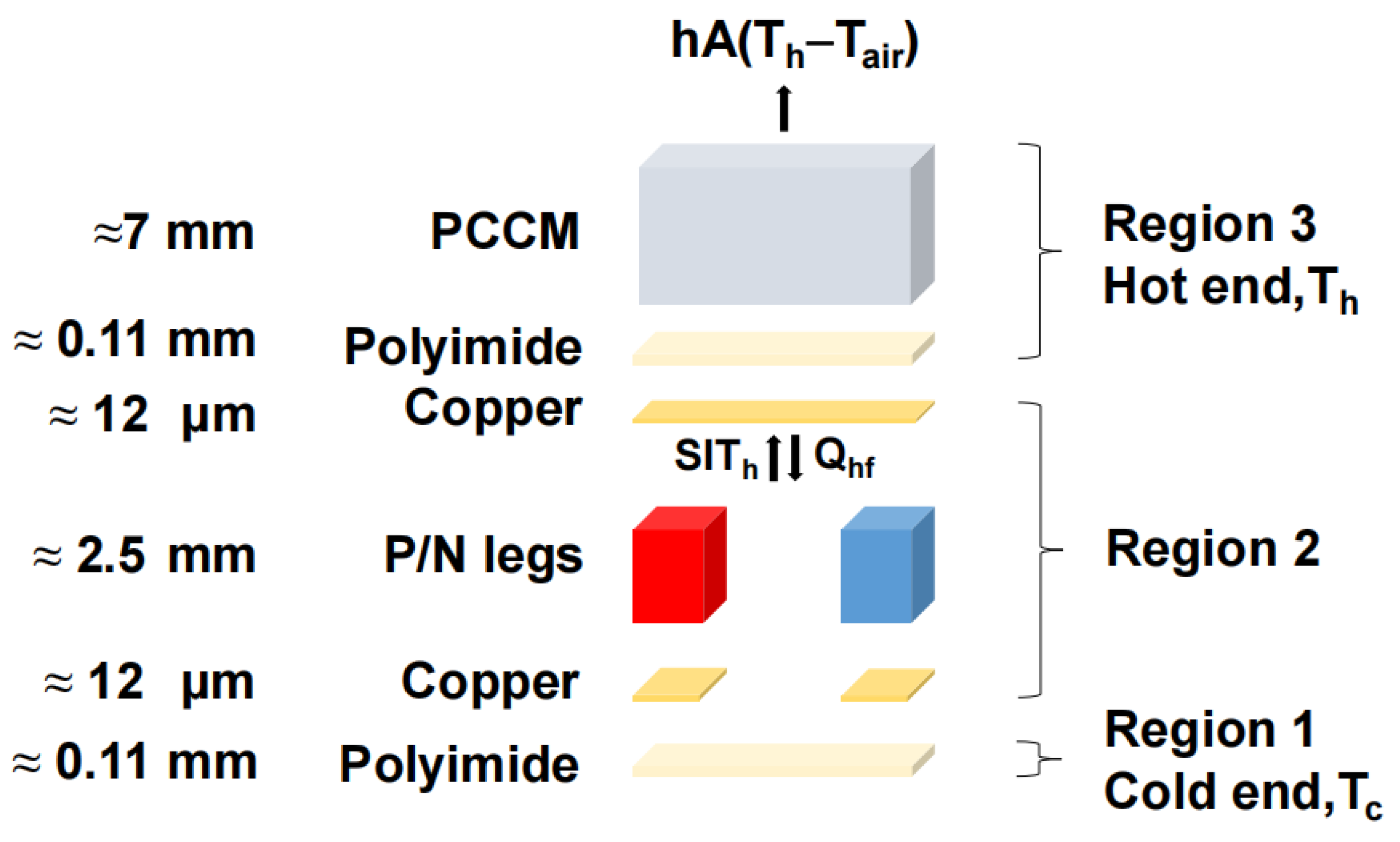
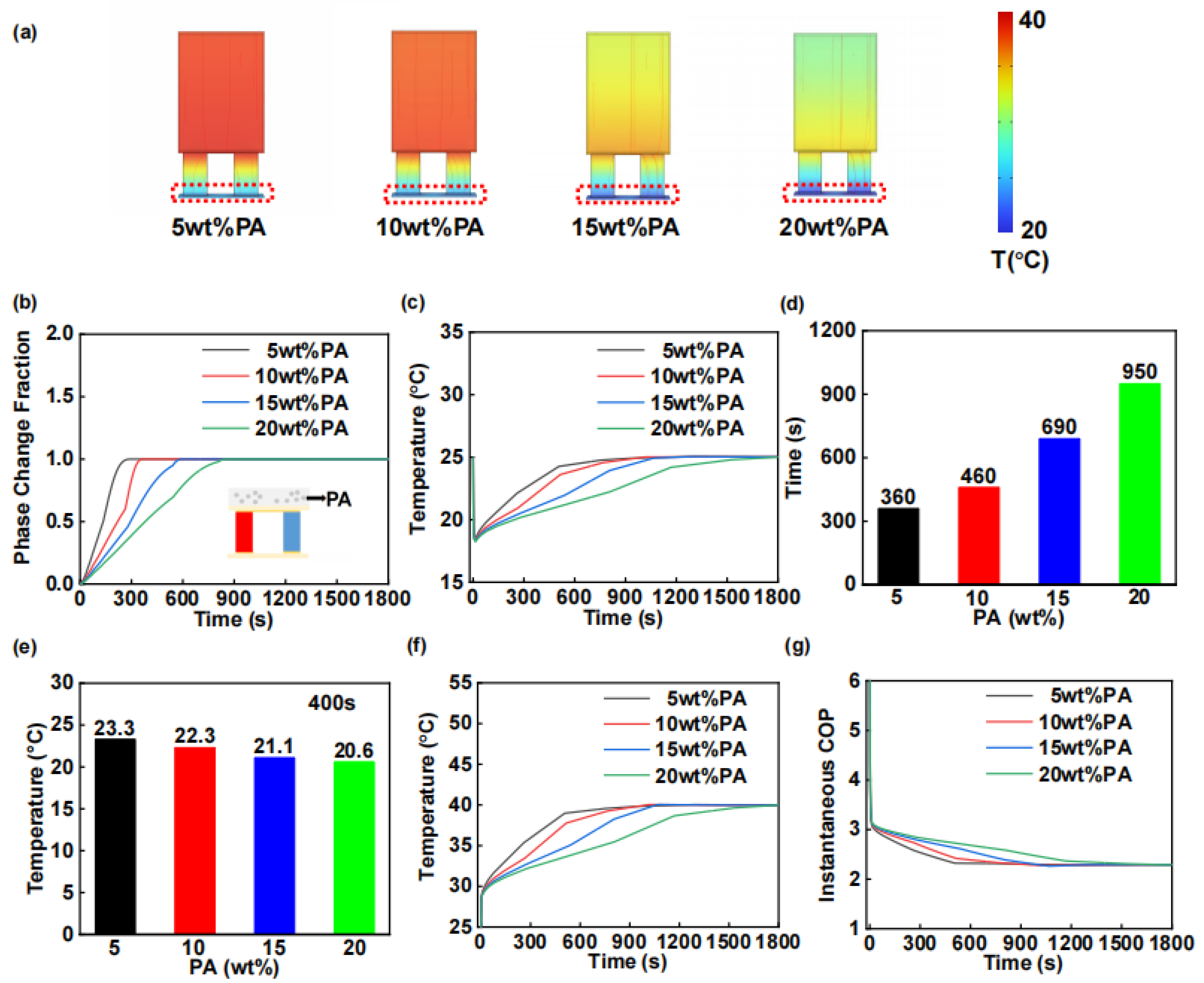

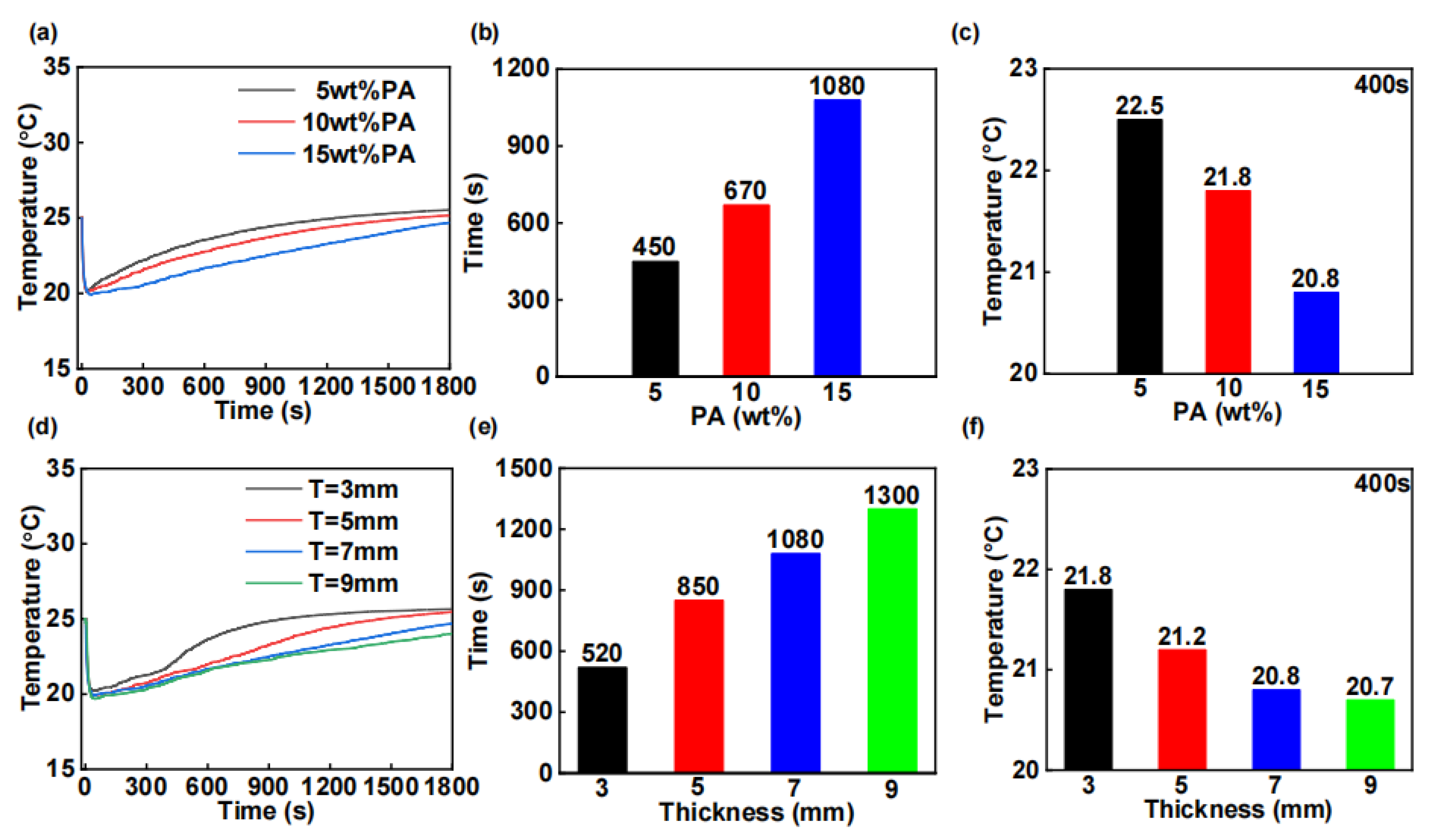
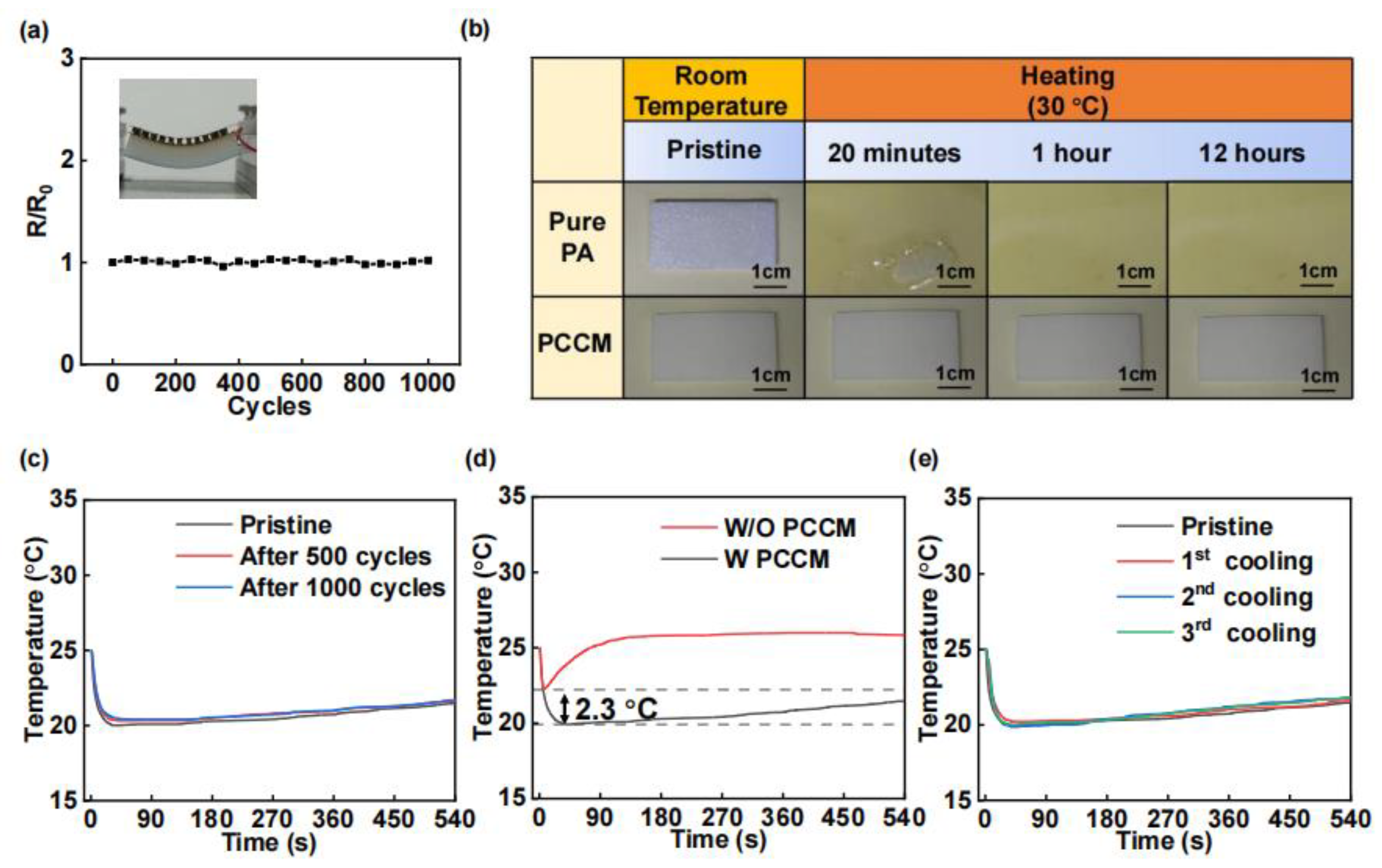

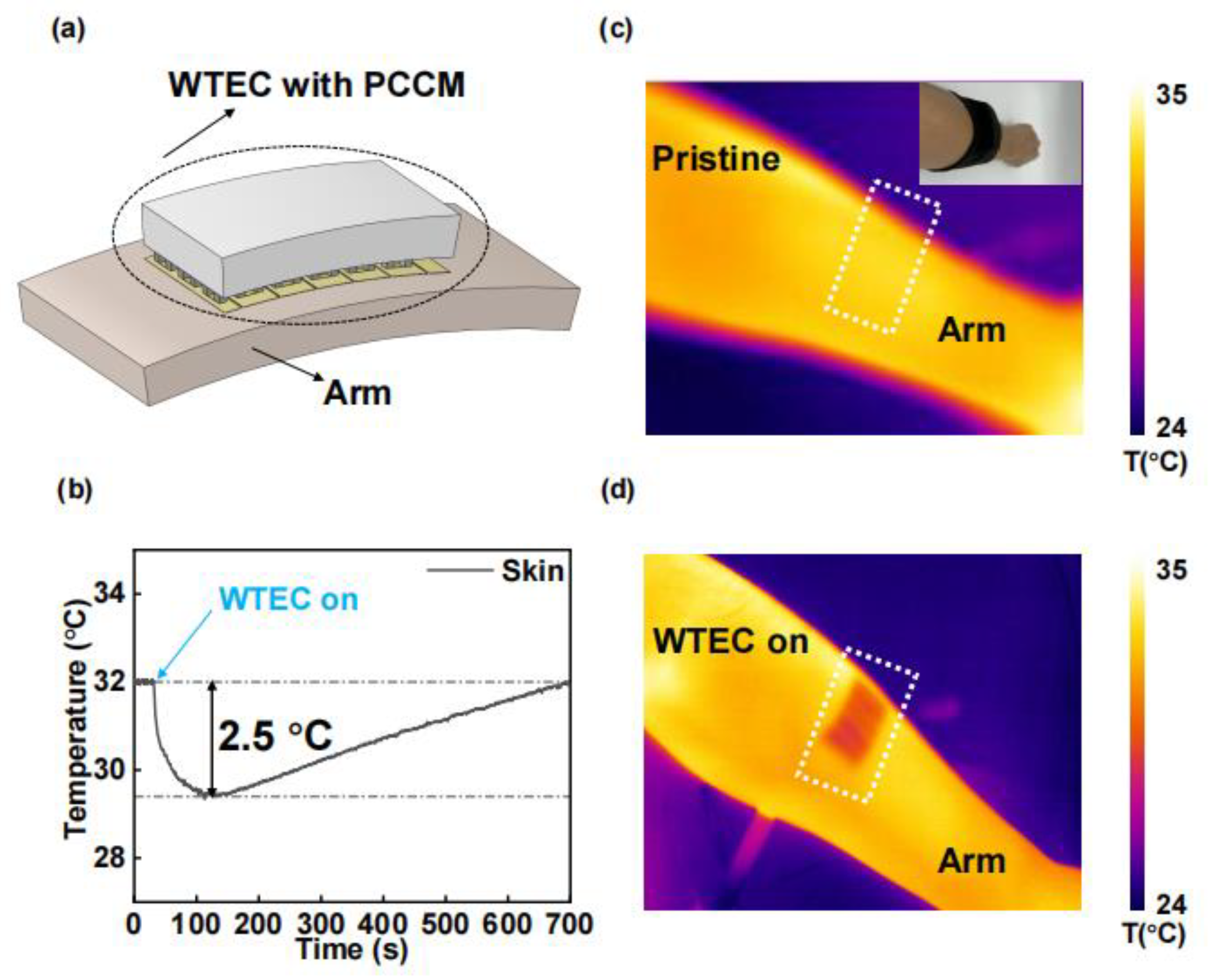
Disclaimer/Publisher’s Note: The statements, opinions and data contained in all publications are solely those of the individual author(s) and contributor(s) and not of MDPI and/or the editor(s). MDPI and/or the editor(s) disclaim responsibility for any injury to people or property resulting from any ideas, methods, instructions or products referred to in the content. |
© 2025 by the authors. Licensee MDPI, Basel, Switzerland. This article is an open access article distributed under the terms and conditions of the Creative Commons Attribution (CC BY) license (https://creativecommons.org/licenses/by/4.0/).
Share and Cite
Xia, Z.; Cao, W.; Sun, X.; Ding, Q.; Zhu, Z.; Zhou, W.; Yan, S.; Hou, Y.; Wang, Z. Performance Study of Wearable Thermoelectric Cooler with Phase-Change Composite Heat Sink. Materials 2025, 18, 1576. https://doi.org/10.3390/ma18071576
Xia Z, Cao W, Sun X, Ding Q, Zhu Z, Zhou W, Yan S, Hou Y, Wang Z. Performance Study of Wearable Thermoelectric Cooler with Phase-Change Composite Heat Sink. Materials. 2025; 18(7):1576. https://doi.org/10.3390/ma18071576
Chicago/Turabian StyleXia, Zhanglong, Wei Cao, Xiaolong Sun, Qianfeng Ding, Zheng Zhu, Wenjie Zhou, Sijia Yan, Yue Hou, and Ziyu Wang. 2025. "Performance Study of Wearable Thermoelectric Cooler with Phase-Change Composite Heat Sink" Materials 18, no. 7: 1576. https://doi.org/10.3390/ma18071576
APA StyleXia, Z., Cao, W., Sun, X., Ding, Q., Zhu, Z., Zhou, W., Yan, S., Hou, Y., & Wang, Z. (2025). Performance Study of Wearable Thermoelectric Cooler with Phase-Change Composite Heat Sink. Materials, 18(7), 1576. https://doi.org/10.3390/ma18071576






